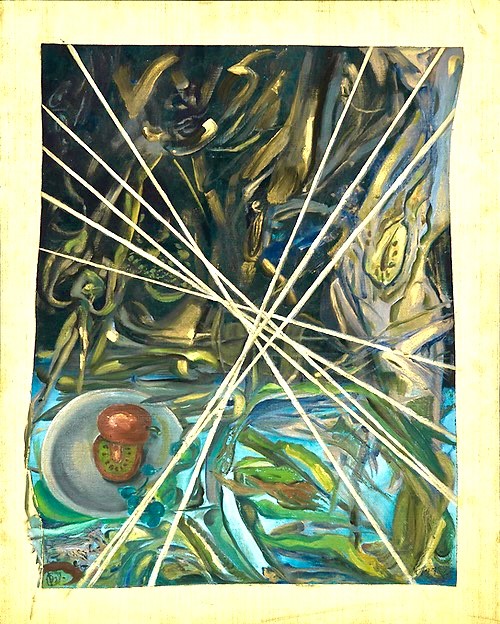Likening their artistic collaboration to dancing the tango—following, giving, and then stepping back, Michelle Gagliano and Beatrix Ost decided to call their venture “Symbiotic Tango.” Chroma Projects is currently showing a selection of Gagliano/Ost works that give us a taste of what the collaboration looks like. A more extensive “Symbiotic Tango” show will be presented by the William King Museum of Art in Abingdon in December.
At Chroma Projects, the work is hung inside its bank vault. This intimate shrine-like setting is the perfect backdrop for pieces limned, framed, and splashed with gold. This precious metal’s glint enlivens an artwork visually, but gold also connotes high value as it pertains to the object and its message. For Gagliano and Ost, this high esteem also extends to the collaboration itself, which has enriched them both in untold ways.
“Before this, I was never drawn to abstraction,” says Ost. “But, now I’m in it. I’m in Michelle’s abstract world.” For Gagliano, working with Ost’s narrative has been expansive. “I never studied surrealism,” she says. “But getting to know Beatrix’s life, and seeing how it extends on to the canvas has been an incredibly enriching experience.”
How did the Gagliano/Ost collaboration come about? Like just about everyone else during the early months of the COVID-19 pandemic, the two artists were struggling with isolation. So in November 2020, they hatched a plan to begin working collaboratively, transforming the ensuing months into a time of flourishing artistic output and creative growth.
One wouldn’t necessarily have thought to put the two artists together. Gagliano produces shimmering atmospheric, abstract compositions, while Ost’s ornate narratives boast a complex surrealist iconography that she uses to explore the human condition. But, this stylistic divergence works to their advantage as each brings her unique perspective to the project. “It’s like a collision of contemporary surrealism and abstracted nature,” says Gagliano.
The women do share many significant similarities. Both derive real sustenance from their practices, which have provided them not only a living, but an identity and psychic fulfillment. They are also each the mother of three sons. But, perhaps most important for their practice, Ost and Gagliano both grew up on large farms: Gagliano on a dairy farm in Upstate New York, and Ost on a farm in Bavaria that specialized in cabbages used in sauerkraut. This birthright has engendered in both artists a deep reverence for nature in its many forms—its bounty, its fury, and its fragility.
Gagliano and Ost work sequentially, completing paintings that they then exchange for the other to add to. To let go of something you’ve labored over to completion, giving it to someone else to work on as they wish, would give most of us pause, and in the beginning, it was challenging for the two. The artists were leery of stepping into the other’s painting for fear of mucking up the vision. It got easier as time passed and they became more in tune to each other and appreciative of the process.
The “Dissected Presence” series of paintings was begun by Ost. The works feature densely packed forms and images from her rich visual lexicon, creating a sumptuous allover effect. In two paintings from the series, an ancient-looking plaster idol reminiscent of the stylized Cycladic schematic figures is affixed to each panel. Their significance isn’t directly spelled out, but they seem to allude to a feminine goddess along the lines of Gaia. All of the works in this series are shot through with diagonal shafts of gold added by Gagliano. These metallic embellishments add a dynamic thrust of movement. They also disrupt the illusion of three-dimensional space, without obscuring the original composition.
Begun by Gagliano and finished by Ost, the series with the same name as the show, “Symbiotic Tango,” has nine paintings. Here, the focus shifts to the surfaces—Gagliano’s forte. She says she was inspired by the James River, with the churn and splash of paint intended to evoke water flowing over rocks. The explosions of paint resemble swirling clouds of vapor and the work can be taken to represent an emergence of some kind. The paintings boast hidden narrative tidbits—faces, birds, strange toothy creatures, a disembodied hand—that one must really look for in order to see. These partial glimpses of recognizable things amid the chaos of swirling medium suggest an excavated wall where only fragmentary sections remain, with the rest degraded or covered with dust or mud. Ost revels in these instances where the abstract meets the surreal. “That’s how the mind works,” she says. “It understands both the abstract and the surreal. It’s the eyes that want order.”
Working as an artist can be a very solitary pursuit. Many spend hours alone in the studio trying to figure things out. With another artist in the mix, it’s not only companionable, but there’s another person invested in the process to act as a sounding board. This is helpful in completing a piece by reinforcing the decisions and choices involved in its creation. It’s also easier to appreciate the artistic output and derive pleasure from its creation because you have someone else experiencing the same reaction and reinforcing one’s own. “I get so much from her and she gets so much from me,” says Ost. It’s a joint endeavor of listening, trust, and support.
